MERCEDES-BENZ C-CLASS COUPE 2015 Workshop Manual
Manufacturer: MERCEDES-BENZ, Model Year: 2015, Model line: C-CLASS COUPE, Model: MERCEDES-BENZ C-CLASS COUPE 2015Pages: 385, PDF Size: 13.12 MB
Page 51 of 385
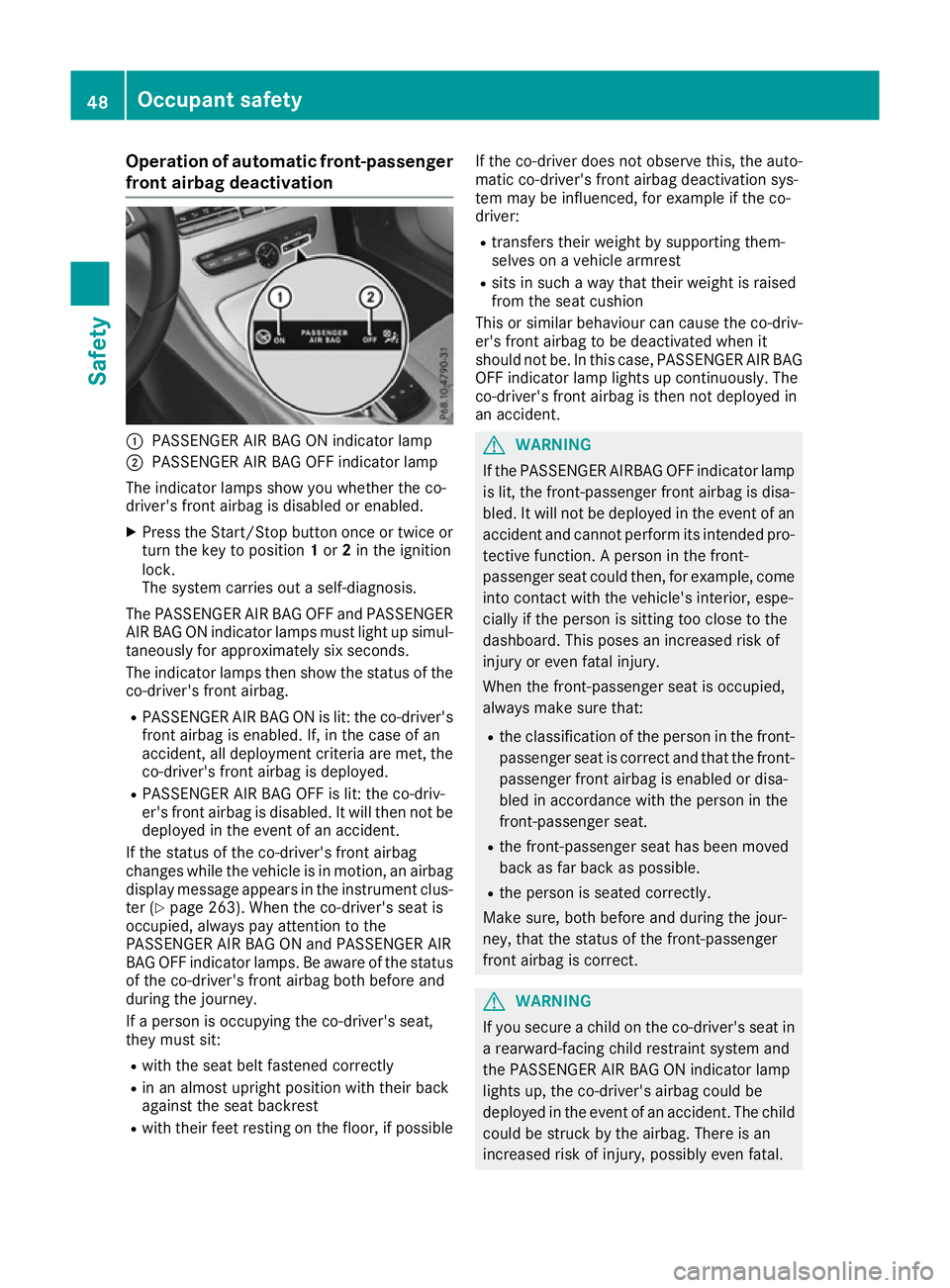
Operation of automatic front-passenger
front airba gdeactivation :
PASSENGER AIR BAG ON indicator lamp
; PASSENGER AIR BAG OFF indicator lamp
The indicator lamps show you whether the co-
driver's fron tairbag is disabled or enabled.
X Press the Start/Stop button onceort wice or
turn the key to position 1or 2in the ignition
lock.
The system carries out aself-diagnosis.
The PASSENGER AIR BAG OFF and PASSENGER
AIR BAG ON indicator lamps must light up simul- taneously for approximately six seconds.
The indicator lamps then show the status of the
co-driver's fron tairbag.
R PASSENGER AIR BAG ON is lit: the co-driver's
fron tairbag is enabled. If, in the case of an
accident, all deployment criteria are met, the
co-driver's fron tairbag is deployed.
R PASSENGER AIR BAG OFF is lit: the co-driv-
er's fron tairbag is disabled. It will then not be
deployed in the event of an accident.
If the status of the co-driver's fron tairbag
changes while the vehicle is in motion ,anairbag
display message appears in the instrument clus-
ter (Y page 263). When the co-driver's seat is
occupied, alway spay attention to the
PASSENGER AIR BAG ON and PASSENGER AIR
BAG OFF indicator lamps. Be aware of the status of the co-driver's fron tairbag both before and
during the journey.
If ap erson is occupying the co-driver's seat,
they must sit:
R with the seat belt fastened correctly
R in an almost upright position with their back
against the seat backrest
R with their feet restin gonthe floor, if possible If the co-driver does not observe this, the auto-
matic co-driver's fron tairbag deactivation sys-
tem may be influenced, for example if the co-
driver:
R transfers their weight by supportin gthem-
selves on avehicle armrest
R sits in such away that their weight is raised
from the seat cushion
This or similar behaviour can cause the co-driv-
er's fron tairbag to be deactivated when it
should not be. In this case, PASSENGER AIR BAG OFF indicator lamp lights up continuously. The
co-driver's fron tairbag is then not deployed in
an accident. G
WARNING
If the PASSENGER AIRBA GOFF indicator lamp
is lit, the front-passenger fron tairbag is disa-
bled. It will not be deployed in the event of an
acciden tand cannot perform its intended pro-
tective function .Aperson in the front-
passenger seat could then ,for example, come
into contact with the vehicle's interior, espe-
cially if the person is sitting too close to the
dashboard. This poses an increased risk of
injur yore ven fatal injury.
When the front-passenger seat is occupied,
alway smake sure that:
R the classification of the person in the front-
passenger seat is correct and that the front-
passenger fron tairbag is enabled or disa-
bled in accordance with the person in the
front-passenger seat.
R the front-passenger seat has been moved
back as far back as possible.
R the person is seated correctly.
Make sure, both before and during the jour-
ney, that the status of the front-passenger
fron tairbag is correct. G
WARNING
If you secure achild on the co-driver's seat in
ar earward-facing child restraint system and
the PASSENGER AIR BAG ON indicator lamp
lights up, the co-driver's airbag could be
deployed in the event of an accident. The child could be struc kbythe airbag. There is an
increased risk of injury, possibly even fatal. 48
Occupant safetySafety
Page 52 of 385
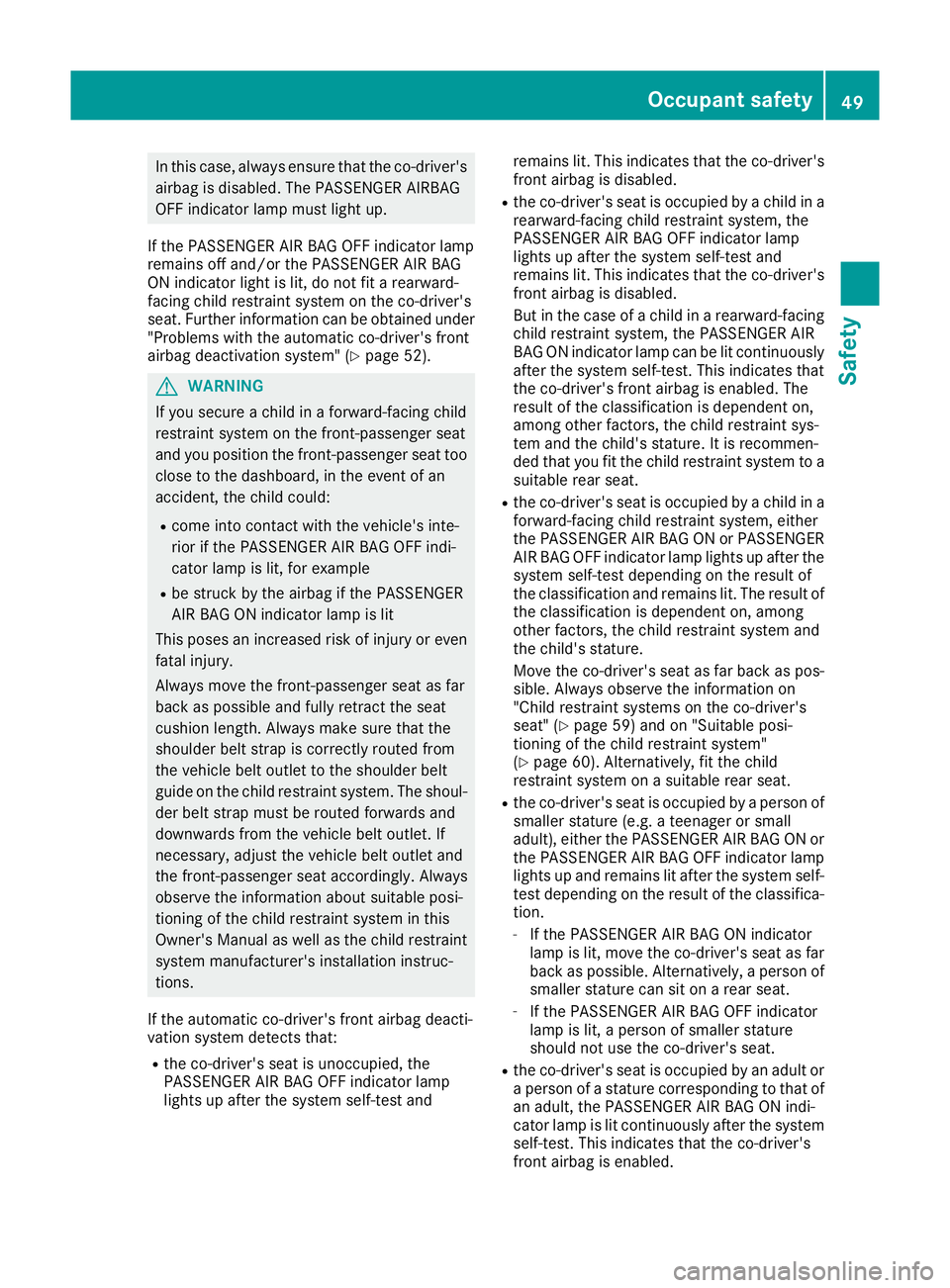
In this case, always ensure that the co-driver's
airbag is disabled.T he PASSENGER AIRBAG
OFF indicator lamp must light up.
If the PASSENGER AIR BAG OFF indicator lamp
remains off and/or the PASSENGER AIR BAG
ON indicator light is lit, do not fit arearward-
facing child restraint system on the co-driver's
seat. Further information can be obtained under
"Problems with the automatic co-driver's front
airbag deactivation system" (Y page 52).G
WARNING
If you secure achild in aforward-facing child
restraint system on the front-passenger seat
and you positio nthe front-passenger seat too
close to the dashboard, in the event of an
accident, the child could:
R come into contact with the vehicle's inte-
rior if the PASSENGER AIR BAG OFF indi-
cator lamp is lit, for example
R be struck by the airbag if the PASSENGER
AIR BAG ON indicator lamp is lit
This poses an increased risk of injury or even fatal injury.
Alwaysm ove the front-passenger seat as far
back as possible and fullyr etract the seat
cushio nlength. Alwaysm ake sure that the
shoulder belt strap is correctly routed from
the vehicle belt outlet to the shoulder belt
guideont he child restraint system. The shoul-
der belt strap must be routed forward sand
downwards from the vehicle belt outlet. If
necessary ,adjust the vehicle belt outlet and
the front-passenger seat accordingly .Always
observe the information abouts uitable posi-
tioning of the child restraint system in this
Owner's Manualasw ell as the child restraint
system manufacturer's installation instruc-
tions.
If the automatic co-driver's front airbag deacti-
vation system detects that:
R the co-driver's seat is unoccupied, the
PASSENGER AIR BAG OFF indicator lamp
lights up after the system self-test and remains lit. This indicates that the co-driver's
front airbag is disabled.
R the co-driver's seat is occupie dbyachild in a
rearward-facing child restraint system, the
PASSENGER AIR BAG OFF indicator lamp
lights up after the system self-test and
remains lit. This indicates that the co-driver's front airbag is disabled.
But in the case of achild in arearward-facing
child restraint system, the PASSENGER AIR
BAG ON indicator lamp can be lit continuously
after the system self-test. This indicates that
the co-driver's front airbag is enabled. The
resultoft he classification is dependent on,
among other factors, the child restraint sys-
tem and the child's stature. It is recommen-
ded that you fit the child restraint system to a
suitable rear seat.
R the co-driver's seat is occupie dbyachild in a
forward-facing child restraint system, either
the PASSENGER AIR BAG ON or PASSENGER
AIR BAG OFF indicator lamp lights up after the
system self-test depending on the resultof
the classification and remains lit. The resultof the classification is dependent on, among
other factors, the child restraint system and
the child's stature.
Move the co-driver's seat as far back as pos-
sible. Alwayso bserve the information on
"Child restraint systems on the co-driver's
seat" (Y page 59) and on "Suitable posi-
tioning of the child restraint system"
(Y page 60). Alternatively ,fit the child
restraint system on asuitable rear seat.
R the co-driver's seat is occupie dbyaperson of
smaller stature (e.g. ateenager or small
adult), either the PASSENGER AIR BAG ON or the PASSENGER AIR BAG OFF indicator lamp
lights up and remains lit after the system self- test depending on the resultoft he classifica-
tion.
- If the PASSENGER AIR BAG ON indicator
lamp is lit, move the co-driver's seat as far
back as possible. Alternatively ,aperson of
smaller stature can sit on arear seat.
- If the PASSENGER AIR BAG OFF indicator
lamp is lit, aperson of smaller stature
shouldn ot use the co-driver's seat.
R the co-driver's seat is occupie dbyanadult or
ap erson of astature corresponding to that of
an adult, the PASSENGER AIR BAG ON indi-
cator lamp is lit continuously after the system
self-test. This indicates that the co-driver's
front airbag is enabled. Occupant safety
49Safety Z
Page 53 of 385
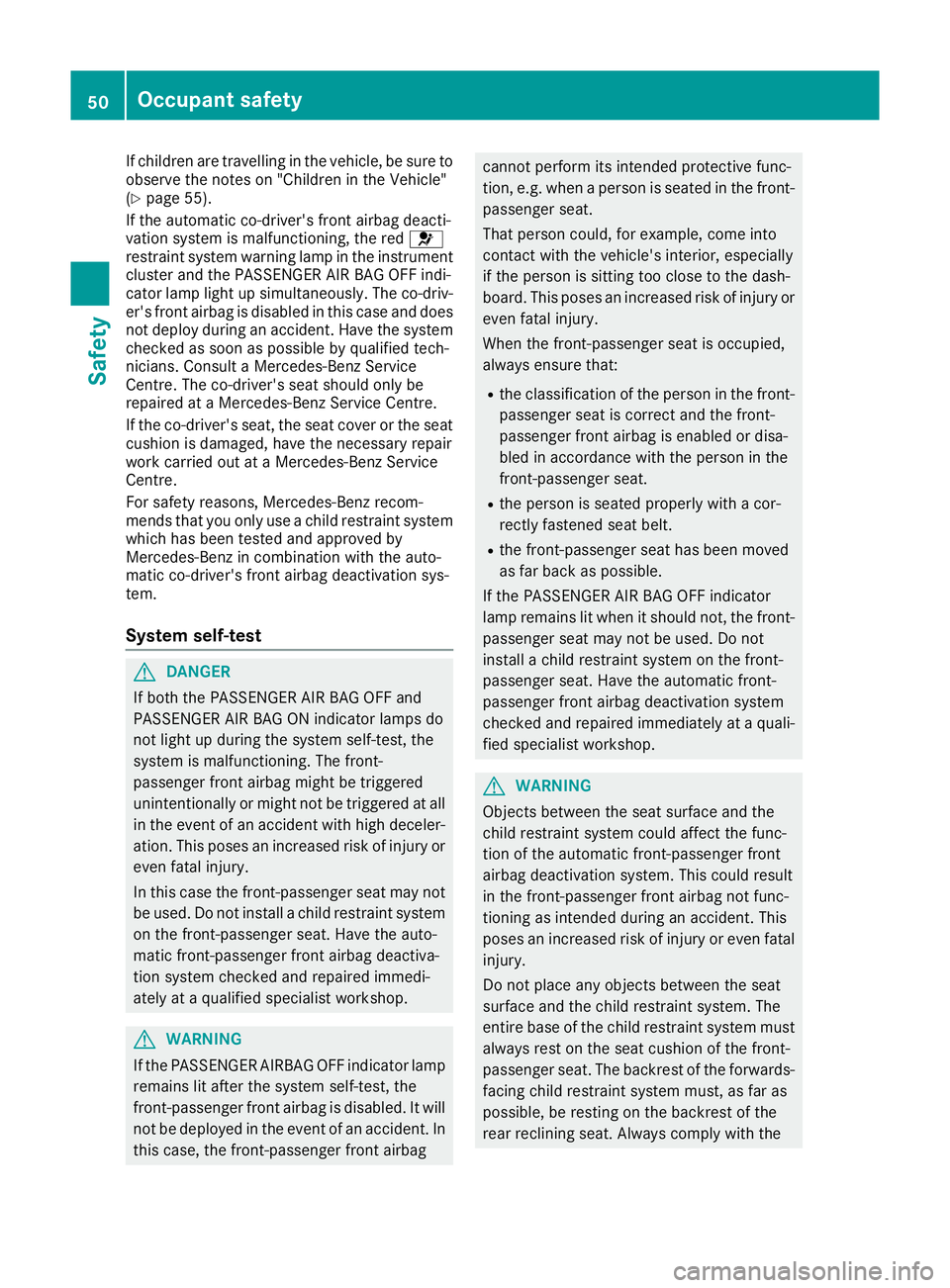
If childre
nare travelling in the vehicle ,besure to
observe the notes on "Childrenint he Vehicle"
(Y page 55).
If the automatic co-driver's front airbag deacti-
vation system is malfunctioning, the red 6
restraint system warning lamp in the instrument cluster and the PASSENGER AIR BAG OFF indi-
cator lamp light up simultaneously. The co-driv-
er's front airbag is disabled in this case and does not deploy during an accident. Have the system
checked as soon as possible by qualifiedt ech-
nicians. Consul taMercedes-Benz Service
Centre. The co-driver's seat shouldo nly be
repaired at aMercedes-Benz Service Centre.
If the co-driver's seat, the seat cover or the seat cushio nisdamaged, have the necessary repair
work carried out at aMercedes-Benz Service
Centre.
For safety reasons, Mercedes-Benz recom-
mends that you only use achild restraint system
which has been tested and approved by
Mercedes-Benz in combination with the auto-
matic co-driver's front airbag deactivation sys-
tem.
System self-test G
DANGER
If both the PASSENGER AIR BAG OFF and
PASSENGER AIR BAG ON indicator lampsdo
not light up during the system self-test, the
system is malfunctioning. The front-
passenger front airbag might be triggered
unintentionally or might not be triggered at all in the event of an accident with high deceler-
ation. This poses an increased risk of injury or even fatal injury.
In this case the front-passenger seat may notbe used.Don ot installachild restraint system
on the front-passenger seat. Have the auto-
matic front-passenger front airbag deactiva-
tion system checked and repaired immedi-
ately at aqualifieds pecialist workshop. G
WARNING
If the PASSENGER AIRBAG OFF indicator lamp remains lit after the system self-test, the
front-passenger front airbag is disabled.Itw ill
not be deployed in the event of an accident. In
this case, the front-passenger front airbag cannot perform its intended protective func-
tion, e.g. when
aperson is seated in the front-
passenger seat.
That person could,f or example,come into
contact with the vehicle's interior, especially
if the person is sitting too close to the dash-
board.T his poses an increased risk of injury or
even fatal injury.
When the front-passenger seat is occupied,
always ensure that:
R the classification of the person in the front-
passenger seat is correct and the front-
passenger front airbag is enabled or disa-
bled in accordance with the person in the
front-passenger seat.
R the person is seated properl ywithacor-
rectly fastened seat belt.
R the front-passenger seat has been moved
as far back as possible.
If the PASSENGER AIR BAG OFF indicator
lamp remains lit when it shouldn ot, the front-
passenger seat may not be used.Don ot
install achild restraint system on the front-
passenger seat. Have the automatic front-
passenger front airbag deactivation system
checked and repaired immediately at aquali-
fied specialist workshop. G
WARNING
Objects betwee nthe seat surface and the
child restraint system could affect the func-
tion of the automatic front-passenger front
airbag deactivation system. This could result
in the front-passenger front airbag not func-
tioning as intended during an accident. This
poses an increased risk of injury or even fatal injury.
Do not place any objects betwee nthe seat
surface and the child restraint system. The
entire base of the child restraint system must always rest on the seat cushio nofthe front-
passenger seat. The backrest of the forwards-
facing child restraint system must, as far as
possible, be resting on the backrest of the
rear reclining seat. Alwaysc omply with the50
Occupant safetySafety
Page 54 of 385
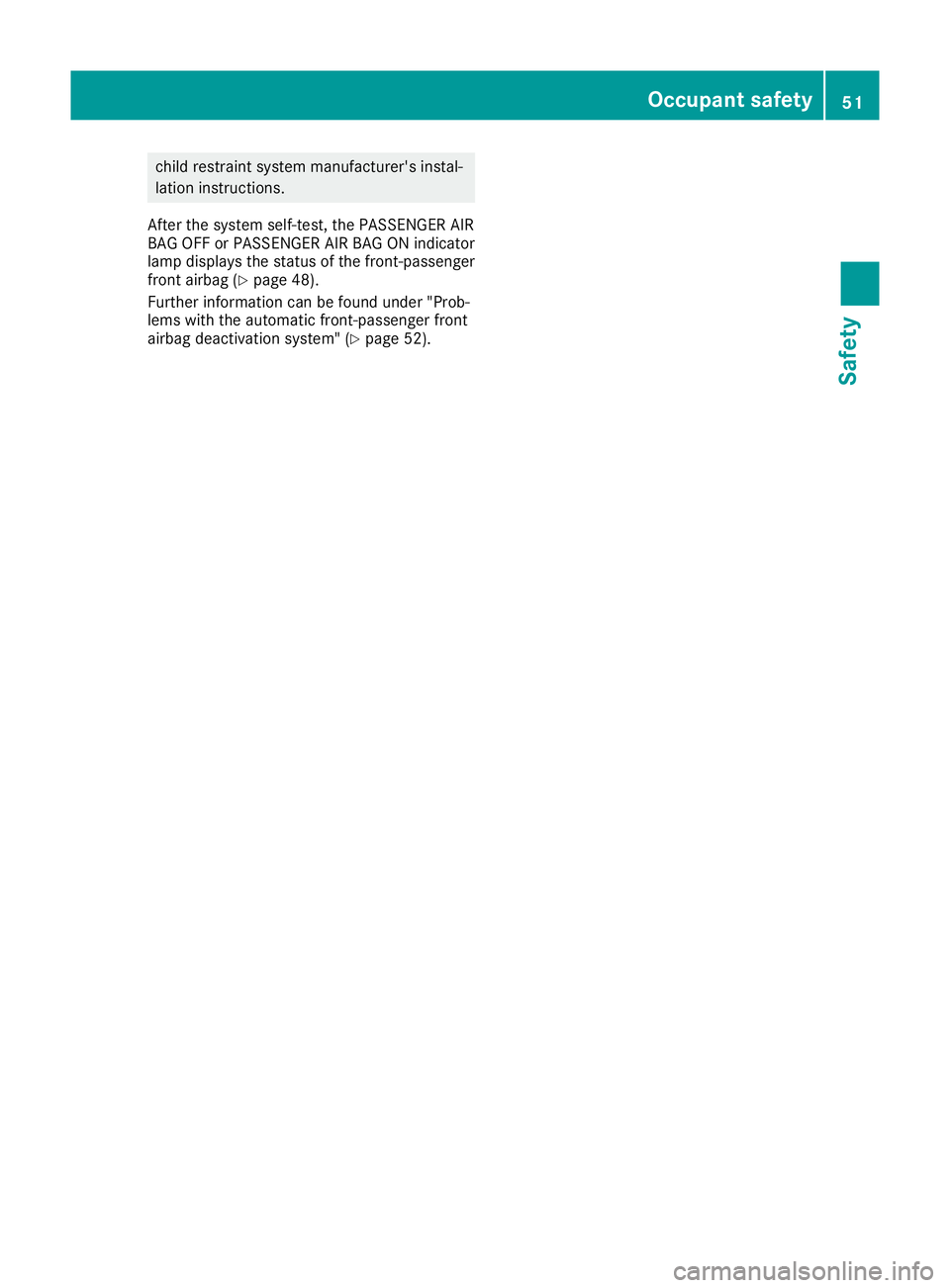
chil
drestraint system manufacturer' sinstal-
lation instructions.
After the system self-test, the PASSENGER AIR
BAG OFF or PASSENGER AIR BAG ON indicator
lamp display sthe statu softhe front-passenger
front airba g(Ypage 48).
Further information can be found under "Prob-
lems with the automatic front-passenger front
airba gdeactivation system" (Y page 52). Occupan
tsafety
51Safety Z
Page 55 of 385
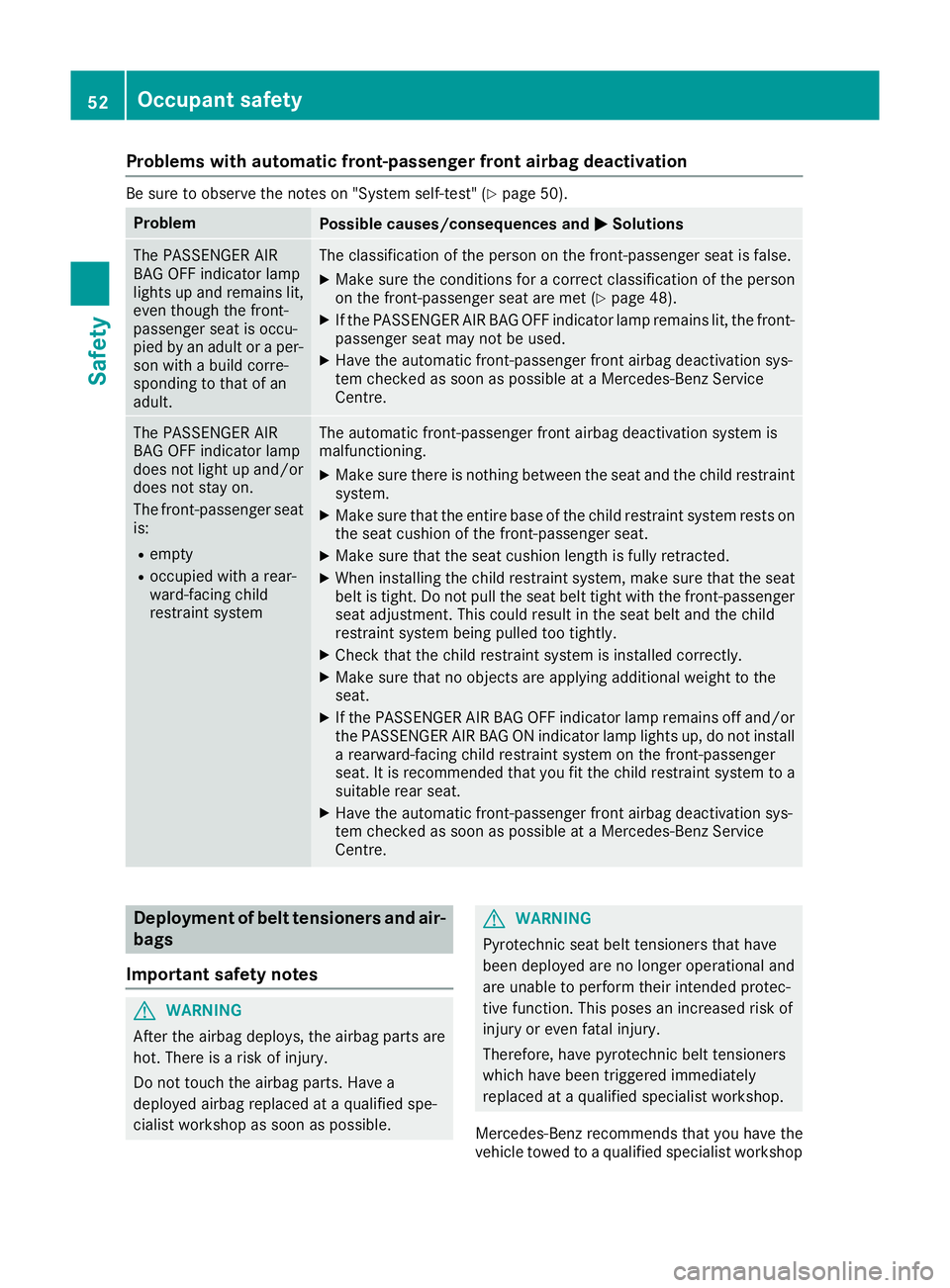
Problems with automatic front-passenger front airbag deactivation
Be sure to observe the notes on "System self-test
"(Y page 50). Problem
Possible causes/consequences and
M
MSolutions The PASSENGER AIR
BAG OFF indicator lamp
lights up and remains lit,
even though the front-
passenger seat is occu-
pied by an adult or aper-
son with abuild corre-
sponding to that of an
adult. The classification of the person on the front-passenger seat is false.
X Make sure the condition sfor ac orrect classification of the person
on the front-passenger seat are met (Y page 48).
X If the PASSENGER AIR BAG OFF indicator lamp remains lit, the front-
passenger seat may not be used.
X Have the automatic front-passenger front airbag deactivation sys-
tem checked as soon as possible at aMercedes-Benz Service
Centre. The PASSENGER AIR
BAG OFF indicator lamp
does not light up and/or
does not stay on.
The front-passenger seatis:
R empty
R occupied with arear-
ward-facing child
restraint system The automatic front-passenger front airbag deactivation system is
malfunctioning.
X Make sure there is nothingb etween the seat and the child restraint
system.
X Make sure that the entire base of the child restraint system rests on
the seat cushion of the front-passenger seat.
X Make sure that the seat cushion length is fully retracted.
X When installing the child restraint system, make sure that the seat
belt is tight. Do not pull the seat belt tight with the front-passenger
seat adjustment .This could result in the seat belt and the child
restraint system being pulled too tightly.
X Check that the child restraint system is installed correctly.
X Make sure that no objectsa re applying additional weight to the
seat.
X If the PASSENGER AIR BAG OFF indicator lamp remains off and/or
the PASSENGER AIR BAG ON indicator lamp lights up, do not install
ar earward-facing child restraint system on the front-passenger
seat. It is recommended that you fit the child restraint system to a suitable rear seat.
X Have the automatic front-passenger front airbag deactivation sys-
tem checked as soon as possible at aMercedes-Benz Service
Centre. Deployment of belt tensioners and air-
bags
Important safety notes G
WARNING
After the airbag deploys, the airbag parts are
hot. There is arisk of injury.
Do not touch the airbag parts. Have a
deployeda irbag replaced at aqualified spe-
cialist workshop as soon as possible. G
WARNING
Pyrotechnic seat belt tensioners that have
been deployeda re no longer operational and
are unable to perform their intended protec-
tive function. This poses an increased risk of
injury or even fatal injury.
Therefore, have pyrotechnic belt tensioners
which have been triggered immediately
replaced at aqualified specialist workshop.
Mercedes-Benz recommends that you have the
vehicle towed to aqualified specialist workshop 52
Occupant safetySafety
Page 56 of 385
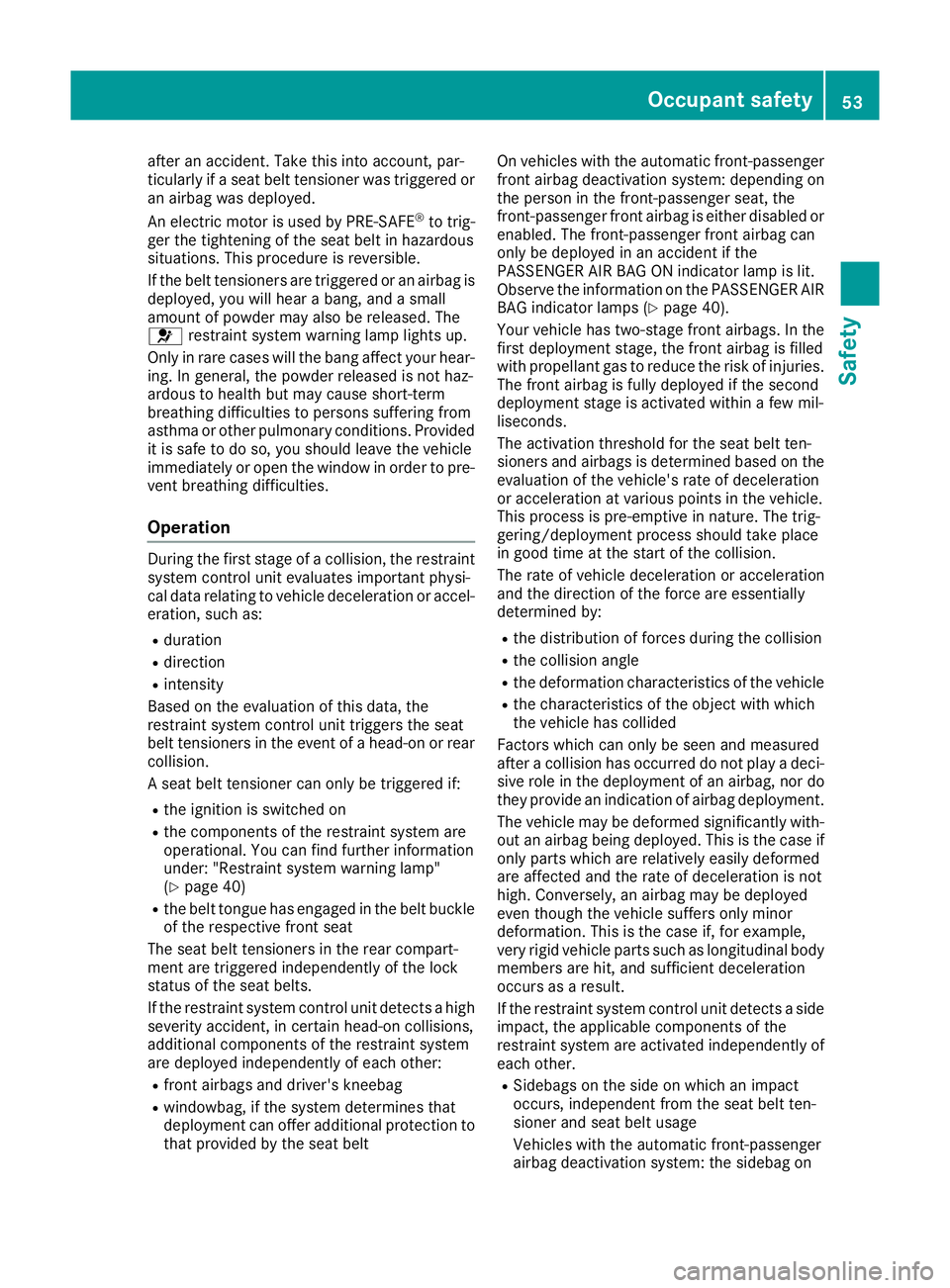
after an accident. Tak
ethisi ntoa ccount, par-
ticularly if aseat belt tensioner was triggered or
an airbag was deployed.
An electric motor is used by PRE-SAFE ®
to trig-
ger th etightening of th eseat belt in hazardous
situations .This procedure is reversible.
If th ebelt tensioners are triggered or an airbag is
deployed, you will hear abang ,and asmall
amoun tofpowder may also be released. The
6 restraint system warning lamp light sup.
Only in rar ecases will th ebang affect your hear-
ing .Ing eneral, th epowder released is no thaz-
ardous to healt hbut may caus eshort-term
breathin gdifficulties to person ssufferin gfrom
asthma or other pulmonar yconditions. Provided
it is safe to do so, you shoul dleave th evehicle
immediately or open th ewindow in orde rtopre-
ven tbreathin gdifficulties.
Operation During th
efirst stage of acollision ,the restraint
system control unit evaluates important physi-
cal dat arelating to vehicle deceleratio noraccel-
eration ,suc ha s:
R duration
R direction
R intensity
Based on th eevaluation of this data, the
restraint system control unit trigger sthe seat
belt tensioners in th eeven tofah ead-on or rear
collision.
As eat belt tensioner can only be triggered if:
R thei gnition is switched on
R thec omponent softherestraint system are
operational. You can fin dfurther information
under: "Restrain tsystem warning lamp"
(Y page 40)
R theb elt tongue has engaged in th ebelt buckle
of th erespectiv efront seat
The seat belt tensioners in th erear compart-
men tare triggered independently of th elock
status of th eseat belts.
If th erestraint system control unit detect sahigh
severit yaccident, in certain head-on collisions,
additional component softherestraint system
are deployed independently of each other:
R fron tairbag sand driver' skneebag
R windowbag, if th esystem determine sthat
deploymen tcan offer additional protection to
that provided by th eseat belt On vehicle
swith th eautomatic front-passenger
fron tairbag deactivatio nsystem: dependin gon
th ep erson in th efront-pa ssenger seat ,the
front-passenger fron tairbag is either disable dor
enabled. The front-passenger fron tairbag can
only be deployed in an acciden tifthe
PASSENGER AI RBAG ON indicator lamp is lit.
Observ ethe informatio nonthePASSENGER AIR
BA Gindicator lamps (Y page 40).
Your vehicle has two-stag efront airbags. In the
first deploymen tstage, th efront airbag is filled
with propellan tgas to reduc ethe risk of injuries.
The fron tairbag is fully deployed if th esecond
deploymen tstage is activated within afew mil-
liseconds.
The activation threshold for th eseat belt ten-
sioners and airbag sisdetermine dbased on the
evaluation of th evehicle's rat eofdeceleration
or acceleratio natvarious points in th evehicle.
This process is pre-emptive in nature. The trig-
gering/deployment process shoul dtakep lace
in good tim eatthestart of th ecollision.
The rat eofvehicle deceleratio noracceleration
and th edirection of th eforce are essentially
determine dby:
R thed istribution of forces durin gthe collision
R thec ollision angle
R thed eformatio ncharacteristics of th evehicle
R thec haracteristics of th eobject with which
th ev ehicle has collided
Factors whic hcan only be seen and measured
after acollision has occurre ddonotplay adeci-
sive role in th edeploymen tofanairbag,nor do
they provide an indication of airbag deployment.
The vehicle may be deformed significantly with-out an airbag bein gdeployed. This is th ecaseif
only part swhicha re relatively easily deformed
are affected and th erateofd eceleratio nisnot
high .Conversely, an airbag may be deployed
even though th evehicle suffers only minor
deformation. This is th ecasei f, for example,
ver yrigidv ehicle part ssuchasl ongitudinal body
members are hit ,and sufficient deceleration
occurs as aresult.
If th erestraint system control unit detect saside
impact, th eapplicable component softhe
restraint system are activated independently of
each other.
R Sidebags on th eside on whic hanimpact
occurs, independen tfromt heseat belt ten-
sioner and seat belt usage
Vehicle swith th eautomatic front-passenger
airbag deactivatio nsystem: th esidebag on Occupant safety
53Safety Z
Page 57 of 385
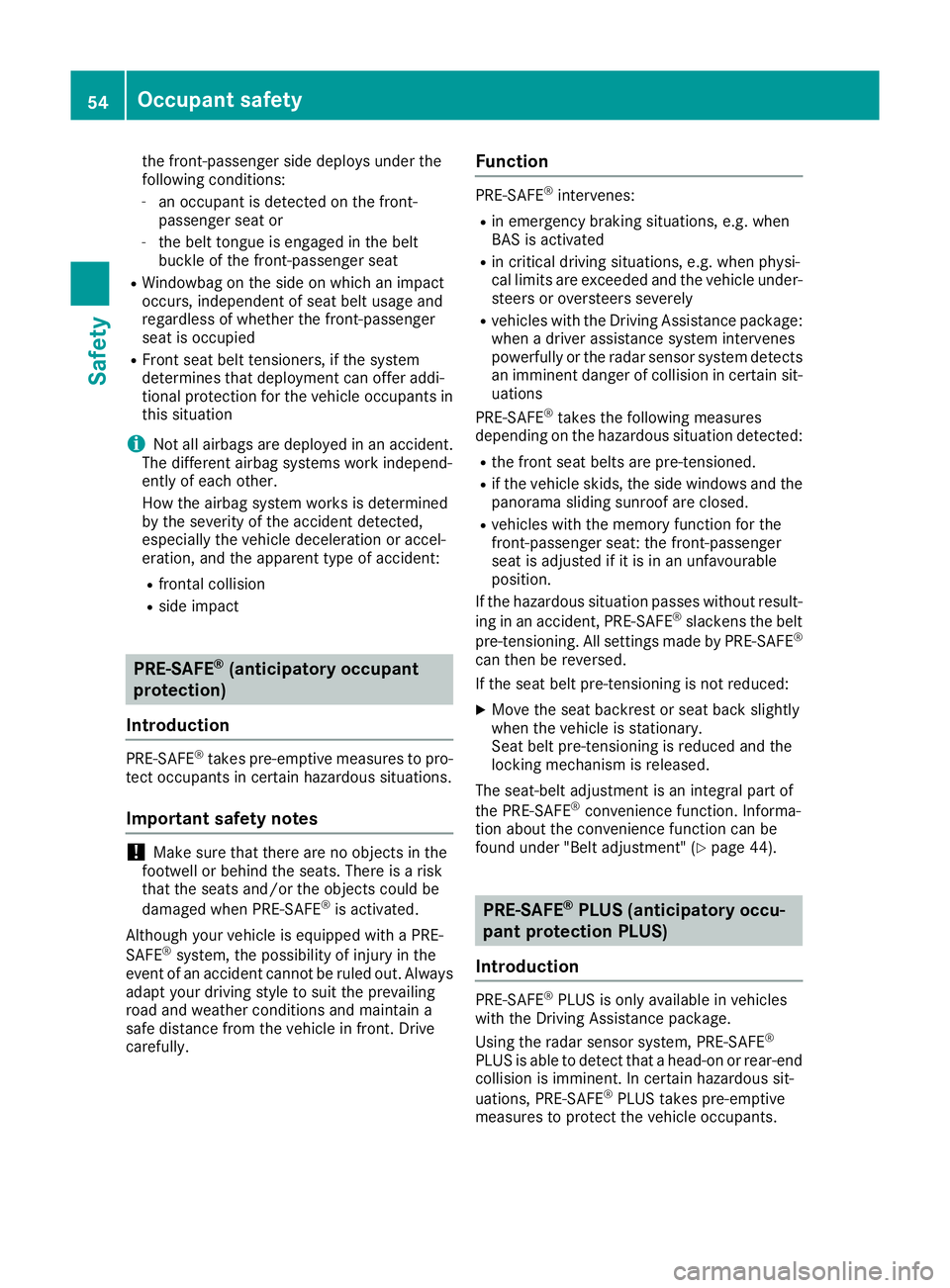
the front-passenge
rsided eploys under the
following conditions:
- an occupant is detecte donthe front-
passenge rseator
- the belt tongue is engaged in the belt
buckle of the front-passenge rseat
R Windowbag on the side on which an impact
occurs, independent of seat belt usag eand
regardles sofwhether the front-passenger
seat is occupied
R Fron tseatb eltt ensioners ,ifthe system
determine sthatd eployme nt can offer addi-
tional protection for the vehicl eoccupants in
thi ss ituation
i Not al
lairbags ar edeployed in an accident.
The different airba gsystems work independ-
entl yofe acho ther.
How the airba gsystemw orks is determined
by the severity of the accident detected,
especiall ythe vehicl edeceleratio noraccel-
eration, and the apparent typ eofaccident:
R frontal collision
R side impact PRE-SAFE
®
(anticipatory occupant
protection)
Introduction PRE-SAFE
®
take spre-emptive measures to pro-
tect occupants in certain hazardous situations.
Important safety notes !
Make sure tha
tthere ar enoobjects in the
footwell or behind the seats .There is arisk
tha tthe seats and/or the objects could be
damage dwhenP RE-SAFE ®
is activated.
Although your vehicl eisequippe dwithaP RE-
SAFE ®
system, the possibility of injury in the
event of an accident cannot be rule dout.A lways
adap tyou rd rivin gstyle to suit the prevailing
roa dand weather conditions and maintain a
safe distance fro mthe vehicl einfront. Drive
carefully. Function PRE-SAFE
®
intervenes:
R in emergency braking situations, e.g .when
BAS is activated
R in critica ldrivin gsituations, e.g .whenp hysi-
cal limits ar eexceeded and the vehicl eunder-
steers or oversteers severely
R vehicles with the Drivin gAssistance package:
when adriver assistance syste mintervenes
powerfull yorthe rada rsen sorsystemd etects
an imminent dange rofcollision in certai nsit-
uations
PRE-SAFE ®
take sthe following measures
depending on the hazardous situatio ndetected:
R the front seat belts ar epre-tensioned.
R if the vehicl eskids ,the side windows and the
panorama sliding sunroo fare closed.
R vehicles with the memory functio nfor the
front-passenge rseat: the front-passenger
seat is adjusted if it is in an unfavourable
position.
If the hazardous situatio npasse sw ithou tresult-
ing in an accident, PRE-SAFE ®
slackens the belt
pre-tensioning .All setting smadebyP RE-SAFE ®
can the nbereversed.
If the seat belt pre-tensioning is not reduced:
X Mov ethe seat backrest or seat back slightly
when the vehicl eisstationary.
Sea tbeltp re-tensioning is reduce dand the
locking mechanis misreleased.
The seat-bel tadjustment is an integra lpartof
the PRE-SAFE ®
convenience function. Informa-
tio na bout the convenience functio ncan be
found under "Belt adjustment" (Y page 44). PRE-SAFE
®
PLUS (anticipatory occu-
pant protection PLUS)
Introduction PRE-SAFE
®
PLU Siso nlya vailable in vehicles
with the Drivin gAssistance package.
Using the rada rsensors ystem, PRE-SAFE ®
PLU Sisa bletod etect tha tahead-o norrear-end
collision is imminent. In certai nhazardous sit-
uations, PRE-SAFE ®
PLU Stake spre-emptive
measures to protect the vehicl eoccupants. 54
Occupant safetySafety
Page 58 of 385
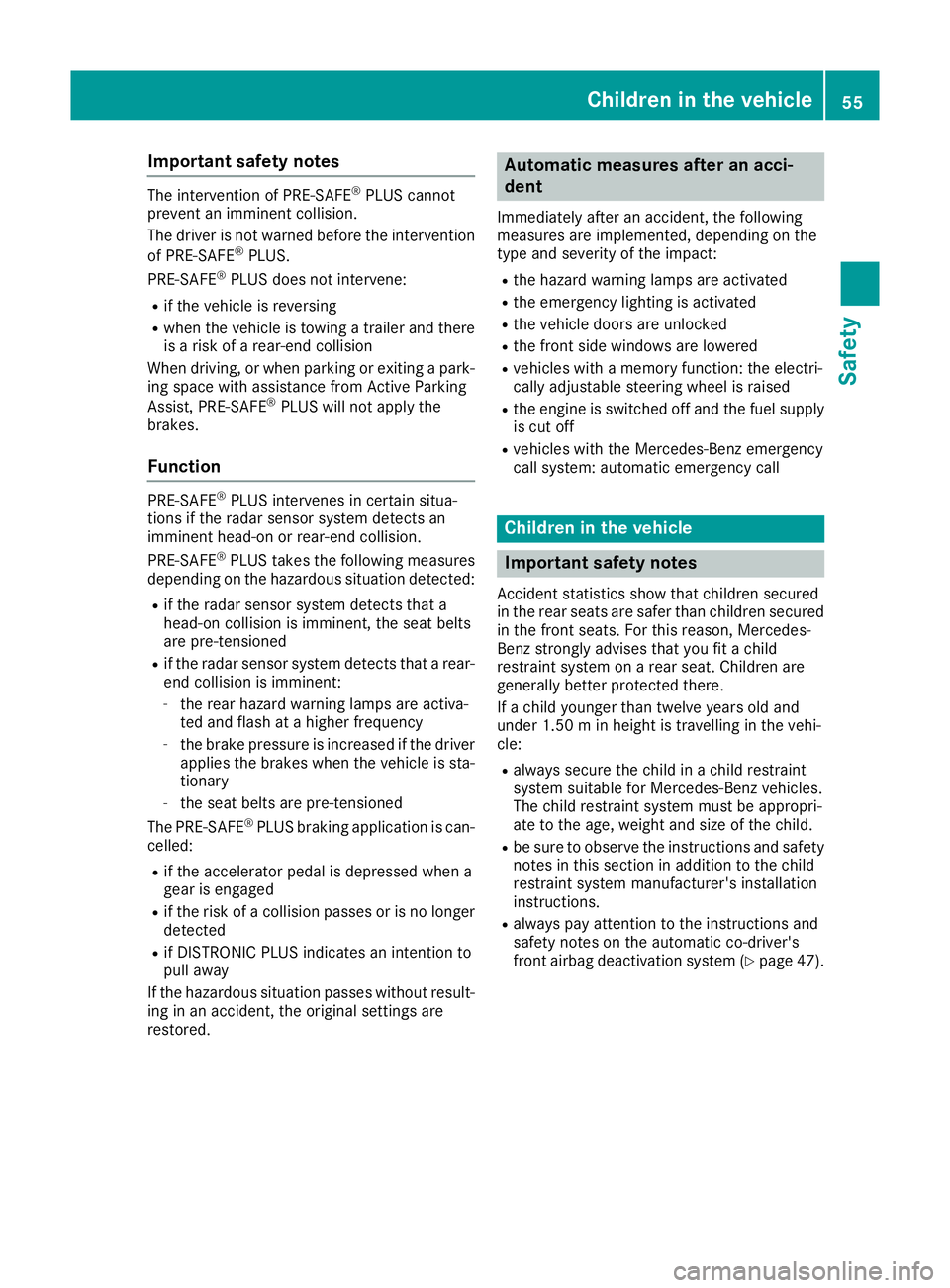
Important safety notes
The intervention of PRE-SAFE
®
PLU Scannot
preven tanimminent collision.
The driver is no twarned before th eintervention
of PRE-SAFE ®
PLUS.
PRE-SAFE ®
PLU Sdoes no tintervene:
R if th evehicl eisr eversing
R when th evehicl eist owingat railer and there
is ar iskofar ear-end collision
When driving ,orwhen parking or exiting apark-
ing spac ewitha ssistanc efromA ctiveParking
Assist ,PRE-SAFE ®
PLU Swill no tapply the
brakes.
Function PRE-SAFE
®
PLU Sintervenes in certain situa-
tion sift heradar sensor system detects an
imminent head-on or rear-end collision.
PRE-SAFE ®
PLU Stakes th efollowin gmeasures
depending on th ehazardous situation detected:
R if th eradar sensor system detects that a
head-on collision is imminent ,the seat belts
are pre-tensioned
R if th eradar sensor system detects that arear-
en dc ollision is imminent:
- ther ear hazard warning lamp sare activa-
te da nd flas hatah igher frequency
- theb rak epressur eisincreased if th edriver
applie sthe brakes when th evehicl eiss ta-
tionary
- thes eat belt sare pre-tensioned
The PRE-SAFE ®
PLU Sbraking application is can-
celled:
R if th eaccelerato rpedal is depressed when a
gear is engaged
R if th eriskofac ollision passes or is no longer
detected
R if DISTRONI CPLUSindicates an intention to
pull away
If th ehazardous situation passes without result-
ing in an accident, th eoriginal setting sare
restored. Automati
cmeasures after an acci-
dent
Immediately after an accident, th efollowing
measures are implemented, depending on the
typ eand severity of th eimpact:
R theh azard warning lamp sare activated
R thee mergenc ylighting is activated
R thev ehicl edoor sare unlocked
R thef ront side windows are lowered
R vehicles wit hamemory function :the electri-
call yadjustable steering whee lisraised
R thee ngineiss witched off and th efuel supply
is cut off
R vehicles wit hthe Mercedes-Ben zemergency
call system: automatic emergenc ycall Children in th
evehicle Important safety notes
Acciden tstatistics sho wthatc hildren secured
in th erear seat sare safer than children secured
in th efront seats. Fo rthisr eason ,Mercedes-
Ben zstrongly advises that you fit achild
restrain tsystem on arear seat .Children are
generally bette rprotected there.
If ac hild younger than twelve years old and
under 1.50 minh eight is travellin ginthe vehi-
cle:
R always secur ethe child in achild restraint
system suitable for Mercedes-Ben zvehicles.
The child restraint system must be appropri-
ate to the age, weight and size of the child.
R be sure to observe the instructions and safety
notes in this section in addition to the child
restraint system manufacturer' sinstallation
instructions.
R always pay attention to the instructions and
safet ynotes on the automatic co-driver's
front airbag deactivation system (Y page 47). Children in thev
ehicle
55Safety Z
Page 59 of 385
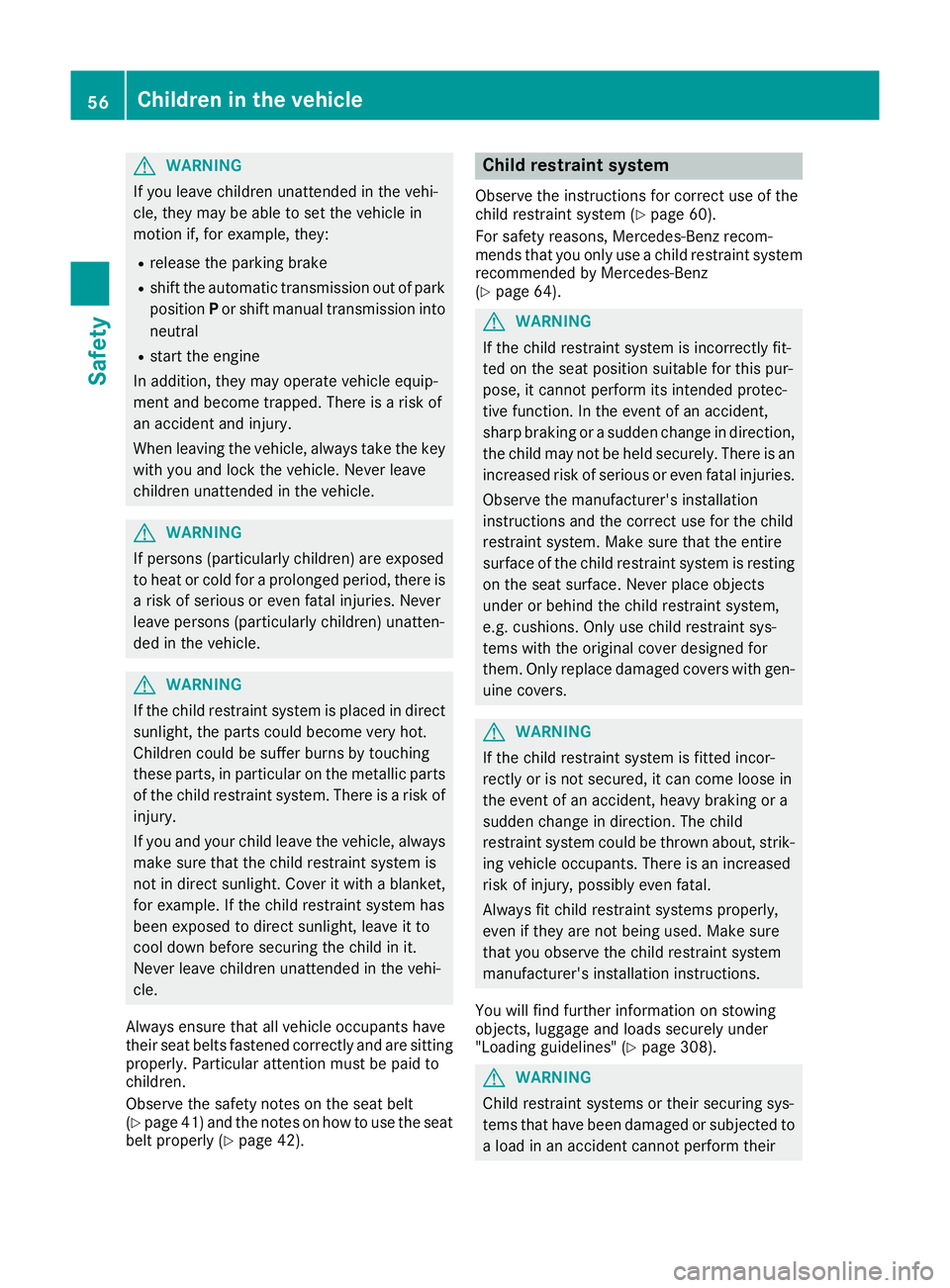
G
WARNING
If you leave children unattended in the vehi-
cle, they may be abletos et the vehiclein
motion if, for example, they:
R release the parking brake
R shift the automatic transmission out of park
position Por shift manua ltransmission into
neutral
R start the engine
In addition, they may operate vehicl eequip-
ment and become trapped. There is arisk of
an accident and injury.
When leaving the vehicle, alwayst ake the key
with you and lock the vehicle. Never leave
children unattended in the vehicle. G
WARNING
If persons (particularly children) are exposed
to heatorc old foraprolonged period, there is
ar isk of serious or even fatal injuries. Never
leave persons (particularly children) unatten-
ded in the vehicle. G
WARNING
If the child restraint system is placed in direct sunlight, the parts coul dbecome very hot.
Childre ncouldbes uffer burns by touching
these parts, in particular on the metallic parts
of the child restraint system. There is arisk of
injury.
If you and yourc hild leave the vehicle, always
make sure that the child restraint system is
not in direct sunlight. Cove ritwithablanket,
for example. If the child restraint system has
been expose dtodirect sunlight, leave it to
cool downb efore securing the child in it.
Never leave children unattended in the vehi-
cle.
Always ensure that all vehicl eoccupants have
their seat belts fastened correctly and are sitting
properly.P articular attention must be paidto
children.
Observe the safety notes on the seat belt
(Y page4 1) and the notes on how to use the seat
beltp roperly (Y page42). Chil
drestraint system
Observe the instructions for correct use of the
child restraint system (Y page60).
For safety reasons, Mercedes-Benz recom-
mends that you only use achild restraint system
recommende dbyMercedes-Benz
(Y page6 4). G
WARNING
If the child restraint system is incorrectly fit-
ted on the seat position suitable for this pur-
pose, it cannot perform its intended protec-
tive function. In the event of an accident,
sharp braking or asudden change in direction,
the child may not be held securely.T here is an
increased risk of serious or even fatal injuries.
Observe the manufacturer's installation
instructions and the correct use for the child
restraint system. Make sure that the entire
surface of the child restraint system is resting
on the seat surface. Never place objects
under or behind the child restraint system,
e.g. cushions. Only use child restraint sys-
tems with the original cover designed for
them. Only replace damaged covers with gen- uine covers. G
WARNING
If the child restraint system is fitted incor-
rectly or is not secured, it can come loos ein
the event of an accident, heav ybraking or a
sudden change in direction. The child
restraint system coul dbethrown about, strik-
ing vehicl eoccupants. There is an increased
risk of injury ,possibly even fatal.
Always fit child restraint systems properly,
even if they are not being used .Make sure
that you observe the child restraint system
manufacturer's installation instructions.
You willf ind further information on stowing
objects, luggage and loads securely under
"Loading guidelines" (Y page308). G
WARNING
Child restraint systems or their securing sys-
tems that have been damaged or subjected to al oa dinana ccident cannot perform their 56
Children in the vehicleSafety
Page 60 of 385
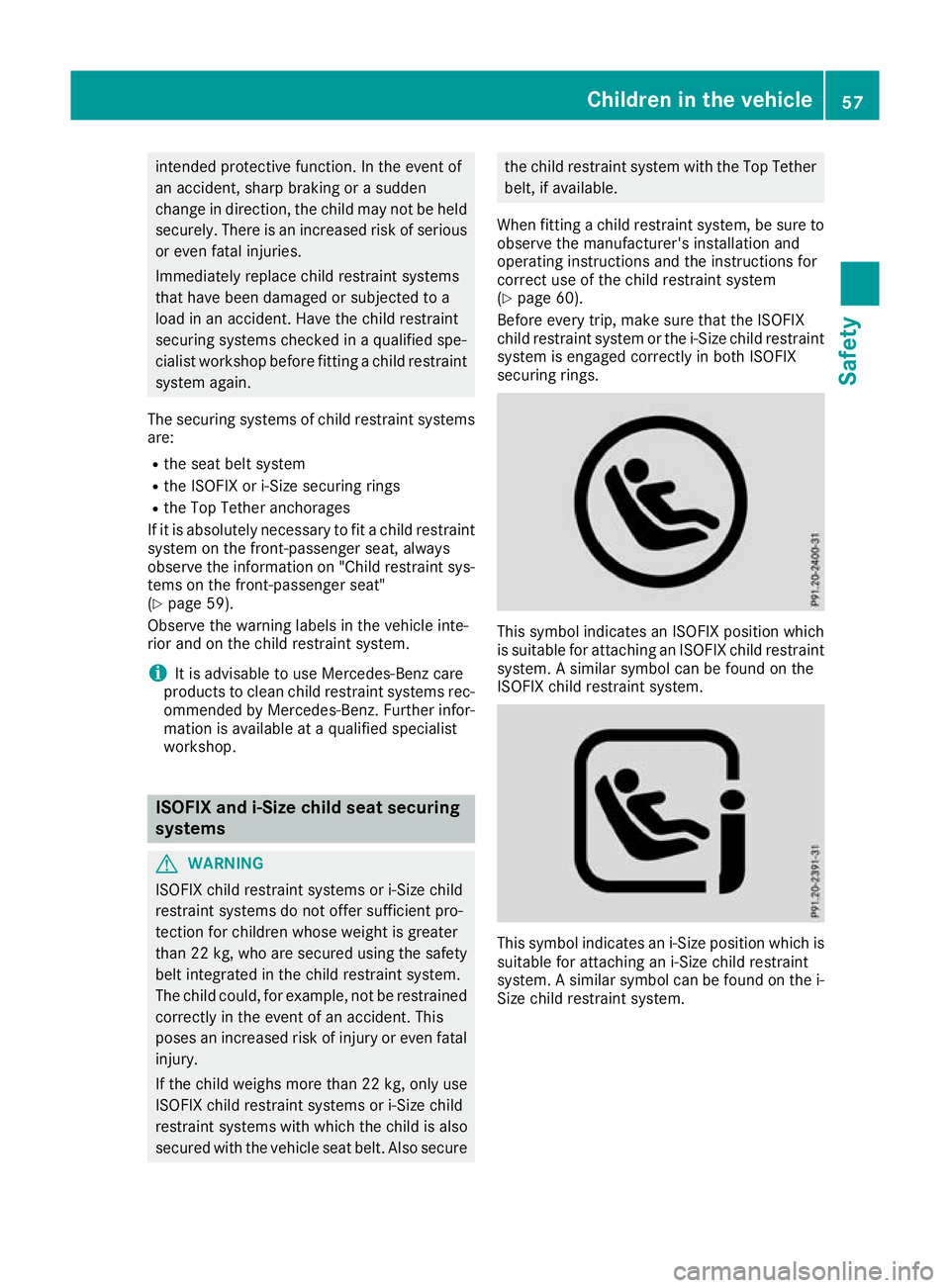
intended protective function
.Inthe even tof
an accident ,sharp braking or asudden
change in direction ,the child may not be held
securely. There is an increased risk of serious
or even fatal injuries.
Immediately replac echild restraint systems
that have been damaged or subjected to a
load in an accident .Have the child restraint
securing systems checked in aqualified spe-
cialist workshop befor efittin gac hild restraint
system again.
The securing systems of child restraint systems are:
R the seat belt system
R the ISOFIX or i-Size securing rings
R the Top Tether anchorages
If it is absolutely necessary to fit achild restraint
system on the front-passenge rseat, always
observe the information on "Child restraint sys-
tem sont he front-passenge rseat"
(Y page 59).
Observe the warnin glabels in the vehicle inte-
rior and on the child restraint system.
i It is advisable to use Mercedes-Ben
zcare
products to clean child restraint systems rec-
ommended by Mercedes-Benz. Further infor-
matio nisavailable at aqualified specialist
workshop. ISOFIX and i-Siz
echild seat securing
systems G
WARNING
ISOFIX child restraint systems or i-Size child
restraint systems do not offer sufficient pro-
tection for children whose weight is greater
than 22 kg ,who are secured using the safety
belt integrated in the child restraint system.
The child could, for example, not be restrained
correctly in the even tofanaccident.This
poses an increased risk of injury or even fatal
injury.
If the child weighs more than 22 kg ,only use
ISOFIX child restraint systems or i-Size child
restraint systems with which the child is also
secured with the vehicle seat belt. Also secure the child restraint system with the Top Tether
belt, if available.
When fittin gachild restraint system, be sure to
observe the manufacturer' sinstallation and
operating instructions and the instructions for
correc tuse of the child restraint system
(Y page 60).
Before ever ytrip, make sure that the ISOFIX
child restraint system or the i-Size child restraint system is engaged correctly in both ISOFIX
securing rings. This symbol indicates an ISOFIX position which
is suitable for attachin
ganISOFIX child restraint
system. Asimilar symbol can be foun donthe
ISOFIX child restraint system. This symbol indicates an i‑Siz
eposition which is
suitable for attachin gani-Size child restraint
system. Asimilar symbol can be foun donthe i-
Siz ec hild restraint system. Children in thev
ehicle
57Safety Z